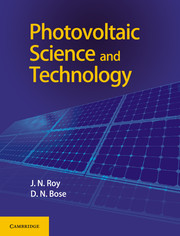Book contents
- Frontmatter
- Dedcation
- Contents
- Figures
- Tables
- Preface
- Acknowledgments
- 1 Introduction to Solar Energy and Solar Photovoltaics
- 2 Crystalline Silicon Cells
- 3 Thin Film Solar Cells
- 4 III-V Compound, Concentrator and Photoelectrochemical Cells
- 5 Organic and Polymer Solar Cells
- 6 Manufacture of c-Si and III-V-based High Efficiency Solar PV Cells
- 7 Manufacture of Solar PV Modules
- 8 Characterization, Testing and Reliability of Solar PV Module
- 9 Overview of Solar PV System Technology and Design
- 10 Design and Implementation of Off-Grid and On-Grid SPV Systems
- Index
- References
9 - Overview of Solar PV System Technology and Design
Published online by Cambridge University Press: 05 July 2018
- Frontmatter
- Dedcation
- Contents
- Figures
- Tables
- Preface
- Acknowledgments
- 1 Introduction to Solar Energy and Solar Photovoltaics
- 2 Crystalline Silicon Cells
- 3 Thin Film Solar Cells
- 4 III-V Compound, Concentrator and Photoelectrochemical Cells
- 5 Organic and Polymer Solar Cells
- 6 Manufacture of c-Si and III-V-based High Efficiency Solar PV Cells
- 7 Manufacture of Solar PV Modules
- 8 Characterization, Testing and Reliability of Solar PV Module
- 9 Overview of Solar PV System Technology and Design
- 10 Design and Implementation of Off-Grid and On-Grid SPV Systems
- Index
- References
Summary
INTRODUCTION
Our conventional energy reserves are limited and have severe environmental impact. There has been all round focus on the development of renewable energy primarily due to these facts, as well as from the perspective of energy security, climate change and energy access. Solar energy has been the Earth's most available energy source, capable of providing many times the total energy demand. Solar Photovoltaic (SPV) deals with conversion of sunlight into electricity. Governments across the world have realized the importance of solar power and over 60 countries have introduced feed-in tariffs, capital subsidies and incentives for productions to promote wider adoption and advancement of SPV. The average growth rate of global SPV capacity has been close to 40%, with the total installed capacity now approaching 350GWP. Renewable energy initiatives, particularly SPV, have picked up pace in India also. The Jawaharlal Nehru National Solar Mission (JNNSM) has been a major initiative of the Government of India to give an impetus to the domestic solar power industry. It sets an ambitious target of 20 GW of solar power capacity by 2022. Several State Governments have announced independent policies in SPV.
Solar PV systems [1–7] occupy a very important place in the SPV value chain (Figure 9.1). As it comes at the end point of the value chain, it decides the amount of power finally supplied. The power generated by a SPV system depends on the previous operations of the value chain as well. In the crystalline silicon (c-Si) technology, the type of wafers (mono or multi) and the efficiency of the solar cells, decided by the cell manufacturing technology, play a very important role. Assembly of the solar cells to make modules has been somewhat straightforward for c-Si technology. Thin film technology (a-Si, CdTe, CIGS, etc.) takes a different route in the value chain diagram (Figure 9.1). The modules are made directly by the Chemical Vapour Deposition (CVD) technique to deposit thin layers of appropriate materials on a conductive glass substrate to form p-n junction solar cell. In this case also the efficiency is decided by several factors such as material (Si, CdTe, CIGS, etc.), structure (amorphous, microcrystalline, etc.) and configuration (single junction, tandem junction, etc.).
- Type
- Chapter
- Information
- Photovoltaic Science and Technology , pp. 320 - 357Publisher: Cambridge University PressPrint publication year: 2017



